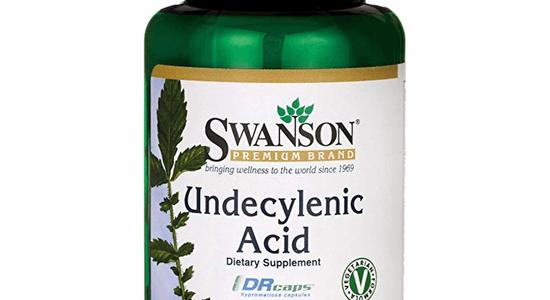See all "Coconut Oil" Section Topics
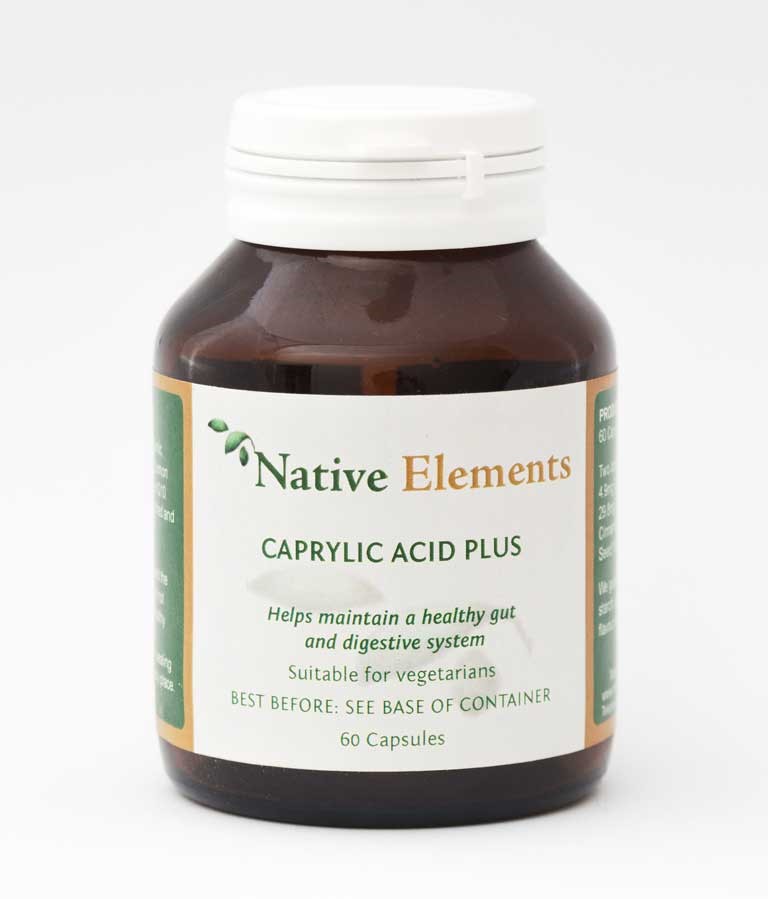
You may have heard that caprylic acid is good for treating a yeast infection; however, it isn’t so great in actuality. Yes, it's true that caprylic acid is a constituent of coconut oil; yet, there are many other fatty acids in coconut oil as well. Only 6 to 9% of coconut oil is actually caprylic acid. The two acids in coconut oil that actually stop Candida well are the primary constituent—lauric acid—and a minor component—capric acid. As the research will indicate, in vitro testing of various fatty acids, showed that caprylic acid did little to nothing in terms of slowing or killing Candida. A 1946 study, published in the Bulletin of the Johns Hopkins Hospital [78 (1946): 333-339], showed that sodium caprylate seemed to work to treat various fungal infections; but sodium caprylate and caprylic acid are two different chemicals.
So it’s a good heads up to understand that anyone who recommends caprylic acid as a treatment for yeast infections just didn’t know what they were talking about. You may want to realize that their information may have been generated in some sloppy fashion and just thrown up on a website. It’s a great signal to determine the quality of the information you get. So to prove that caprylic acid is useless against yeast, let's talk about the in vitro studies which demonstrated this fact!
Caprylic Acid and Candida Research
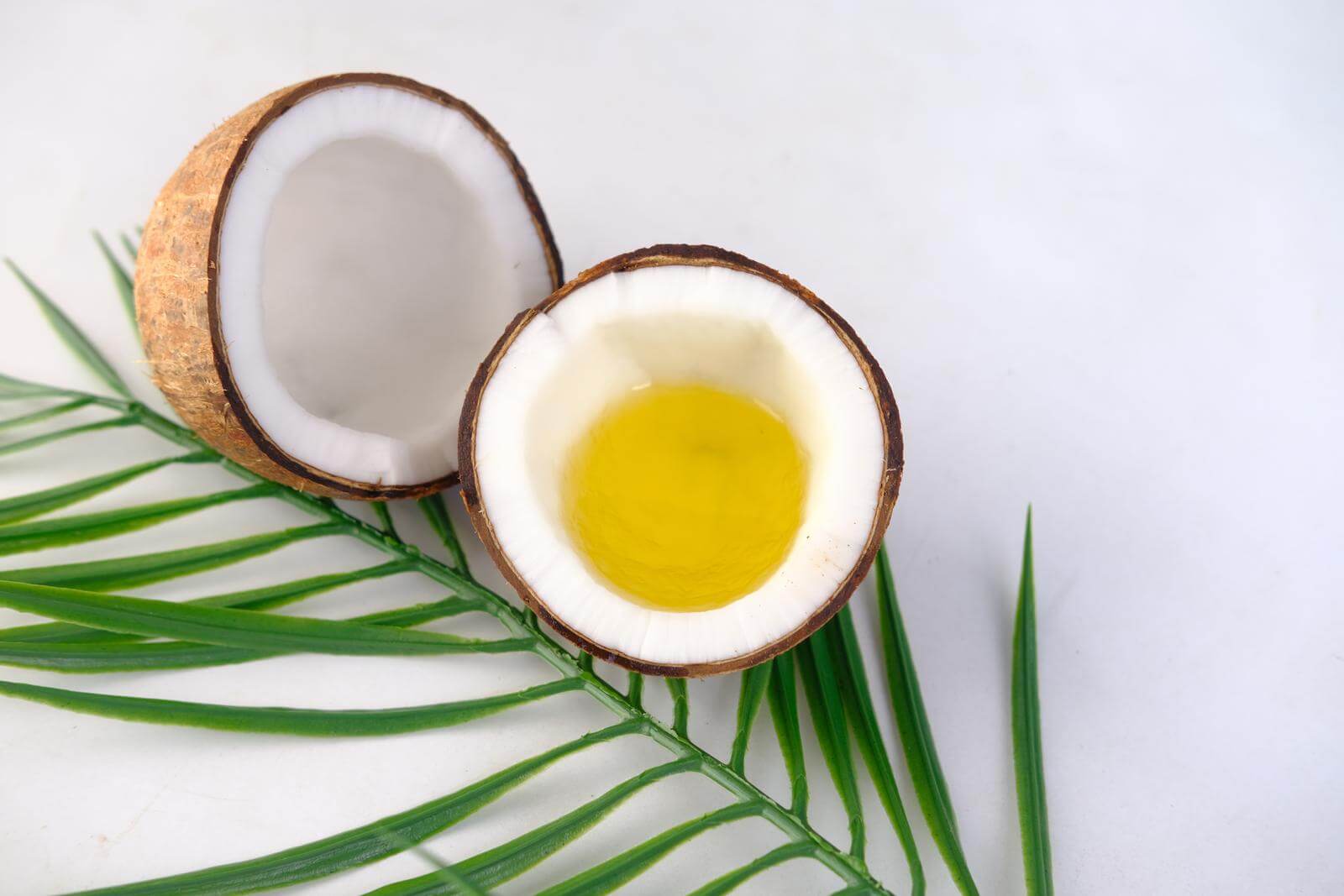
There really are not too many studies out there that demonstrate the efficacy of caprylic acid as a Candida cure. One study, published in the Japanese Journal of Microbiology [5.4 (1961): 383-394], seemed to be cited by many of the people who are selling caprylic acid based yeast infection treatments. Furthermore, what was also troubling is these same products sometimes cited the ability of sodium caprylate to inhibit Candida as a reason to use plain caprylic acid as a treatment. The Japanese Journal of Microbiology [5.4 (1961): 383-394] study concluded that caprylic acid could deter and inhibit Candida albicans. What if, it was really sodium caprylate they were referring too. It may be that an error, such as this, occured in the research paper.
The next two studies we will be discussing showed that caprylic acid did not inhibit Candida albicans. One possible solution for this difference is that the 1961 study published in the Japanese Journal of Microbiology, did not actually use Candida albicans. Prior to 1995, all hyphae growing strains of Candida were referred to as Candida albicans (Sebti, Abdelghani, et al.). And, perhaps the broad categorization of Candida strains, into the albicans species, was even more severe in 1961. The studies we will look at mostly come after 1995; thus, they are more accurate in their determination of what specific species of Candida they are utilizing in their tests. We can possibly conclude, therefore, that this old 1961 study may have not even been using Candida albicans in their test. Thus, we see the disparity between this old study and the more recent research.
The study in the Japanese Journal of Microbiology [5.4 (1961): 383-394] never actually tried to find the minimum inhibitory concentration (MIC) of caprylic acid. The study focused on cellular physiology changes and differences in respiration of the yeast in the presence of caprylic acid. Caprylic acid did disfigure the yeast cells, and the researchers postulated that it created holes in the cells. Also, caprylic acid did slow the respiration of the yeast when it was present—reducing oxygen uptake and glucose oxidation. However, Candida can use anaerobic respiration, and therefore a reduction in oxygen uptake by cells may not impact its growth or virulence (Dumitru, et al.). So it seems, that this study failed to see if a change from aerobic respiration, caused by caprylic acid, actually stopped the anaerobic development of the yeast.
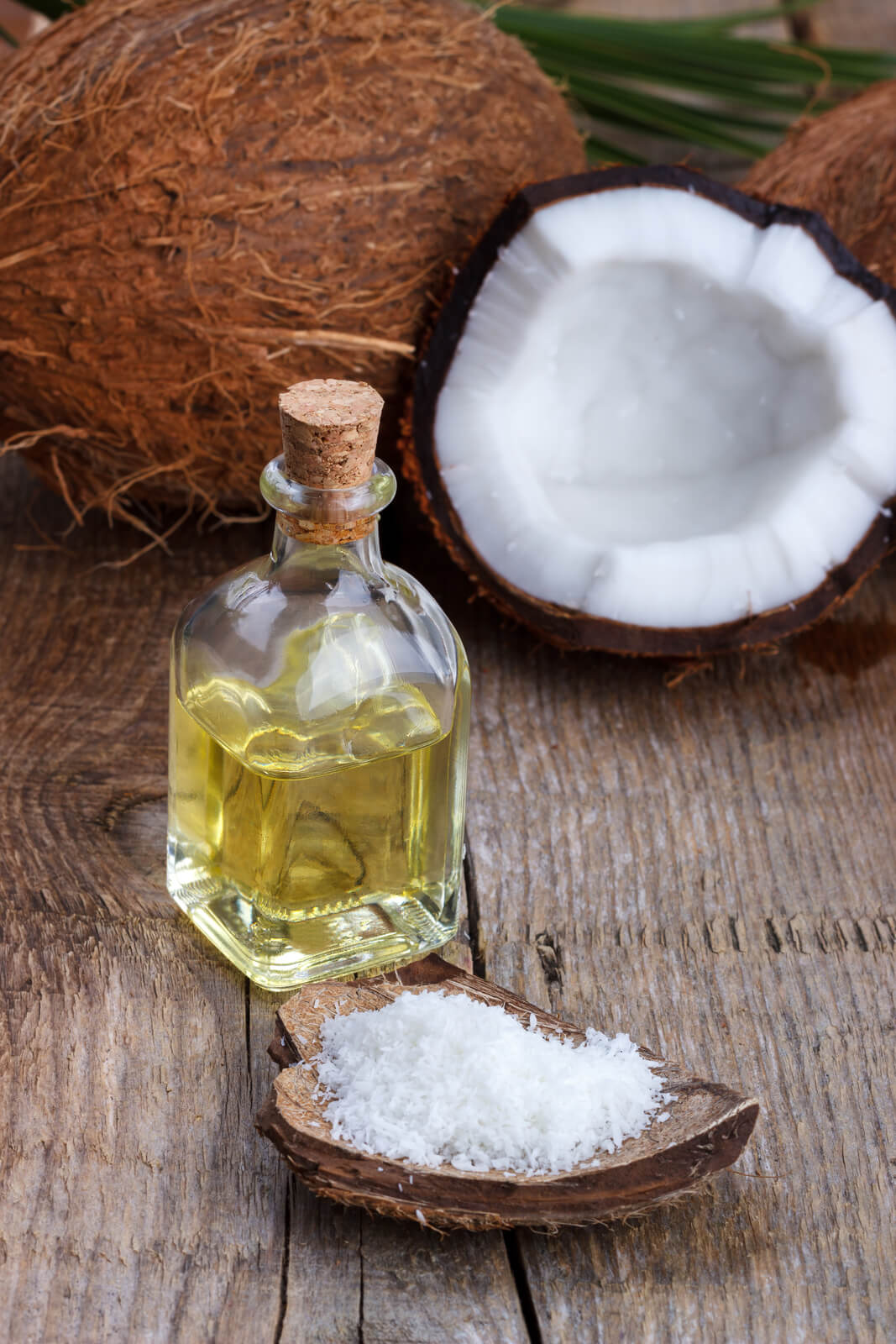
So, now let's take a look at the more recent studies that demonstrated caprylic acid was not able to do much against Candida yeast. The first study we will delve into, was published in the journal Antimicrobial Agents and Chemotherapy [45.11 (2001): 3209-3212]. The study used three distinct strains of Candida albicans and tested their growth in the presence of various fatty acids. The two best inhibitors of the three Candida albicans strains were capric acid and lauric acid. A table from the study illustrates how well these fatty acids stopped Candida growth at various concentrations. But perhaps even more illustrative of the various efficacy of fatty acids, is provided in a chart from the study—which is shown directly below. This chart shows that caprylic acid did little to inhibit the strains of Candida albicans; the acid’s presence allowed the yeast to develop nearly equally as well as it did in the control solution—which did not contain any fatty acids.
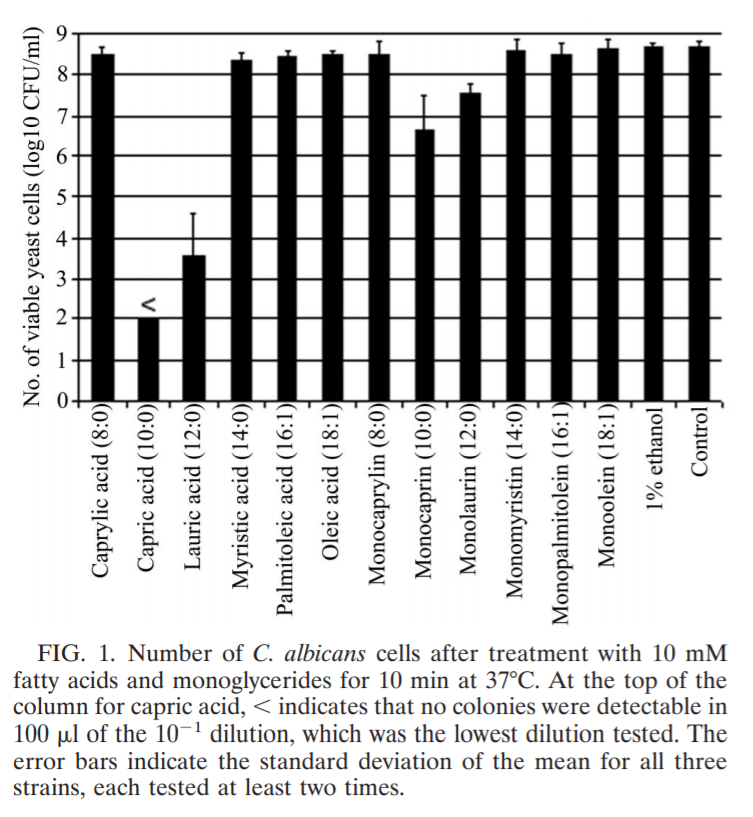
Another earlier study, published in 1972 in the journal Antimicrobial Agents and Chemotherapy [2.1 (1972): 23-28], examined various fatty acids’ effects on various microorganisms. One of these tested microorganisms was defined as Candida albicans. According to the researchers, the strain differences inside the genus of tested organisms did not matter. The authors state: "Strain differences within a genus were not significant by our mode of testing (unpublished data)." So perhaps they are correct in assuming the strain of Candida albicans in their study, which was certainly a hyphal growing strain, is similar to the majority of hyphal positive Candida strains. Since 80% of all Candida infections are caused by Candida albicans, it is likely they indeed had a strain we today would classify as albicans.
The study uncovered similar information to what the 2001 Antimicrobial Agents and Chemotherapy [45.11 (2001): 3209-3212] study discovered. Lauric acid and capric acid were both strong inhibitors of Candida albicans, and caprylic acid (in the study they spelled caprylic as “caprilic”) was not able to inhibit the yeast even at the strongest concentration—which was 1 mg / mL. The best fatty acid for stopping Candida, according to the study results, was Linoleic acid. Linoleic acid is easy to procure, and would therefore be a great addition to coconut oil for treating a yeast infection.
Two studies; and, in my opinion, more informative studies than the 1961 Tsukahara study; showed that caprylic acid is not that great for stopping Candida overgrowth. This old study, is perhaps unreliable, and not demonstrating what two future studies both agree upon. The anaerobic nature of Candida, could perhaps be underestimated by the 1961 research. Overall, caprylic acid is probably not going to do much to stop or help your yeast infection. The two commonly cited studies used to support using caprylic acid are already addressed here in this article. It is likely that, if you hear someone or some website tell you to use caprylic acid, you are just being giving faulty information. This doesn’t mean there aren’t great alternatives; coconut oil is a great natural cure for yeast infections. And, by adding extra capric acid and linoleic acid to the coconut oil, you may be able to supercharge your natural solution for Candida infections! For more information about coconut oil, check out Candida Hub’s extensive delineation of this remedy here: Coconut Oil for Yeast Infection.
A 1/2 Day & Yeast is Gone!
Linda Allen suffered from yeast infections for years. Through researching natural medicine & Candida, she found an efficacious solution!
Linda is one expert you want on your side! Let her show you how to get rid of a superficial yeast infection in just 12 hours; AND, keep it gone!
A 60-day, 100% money back guarantee is provided.
Visit Official Site!A Natural, 12 Hour Yeast Infection Cure

According to a research paper published in Clinical Microbiology Reviews [12.1 (1999): 80-96], Candida species are quite ubiquitous organisms. Candida are most frequently present in the mouth; and, live in 31% to 55% of healthy people. The species that causes approximately 70% to 80% of all Candida infections is C. albicans.
The Chinese Journal of Obstetrics and Gynecology [2011 Jul;46(7):496] reports there appears to be a correlation between intestinal Candida infections and vaginal yeast infections. And, this provides a clue, as to why yeast infections in general, can reoccur.
This study states, in 148 cases of vaginal candida infections, 33.1% of the women were infected in both the intestines and vaginal area. The recurrence rate of yeast infections, in women with simultaneous intestinal infection, was significantly higher than for women who did not have an intestinal infection. This study concluded that vaginal yeast infections are highly associated with simultaneous intestinal Candida infection.
As research appears to indicate, systemic Candida infections can and do happen. A more systemic Candida infection may primarily get a foothold in the intestines; and cause a wide array of problems. If your yeast infections keep happening, a systemic Candida problem may be why.
One woman who suffered from a systemic Candida infection, for about 12 years, was Linda Allen. The systemic Candida infection that attacked Linda caused a wide range of health problems in addition to yeast infections. Some of these problems, Linda describes in her own words in the following quote:
To be honest, it was hard to pinpoint exactly what was wrong: I wasn’t really sick, but I wasn’t really well either. I had listlessness, fatigue, brain fog, stomach ailments, unexplained rashes, skin infections, and so on. It seemed like every day brought a new challenge.
My energy was sapped and I felt exhausted, which affected my grades and put a big dent in my social life.
Linda Allen’s symptoms included an embarrassing vaginal discharge, severe itching, and burning sensations. Her infections were difficult to deal with, and Linda’s health problems cost her financially as well. Linda states these infections of Candida can become excruciating when they happen as frequently as a menstrual period.
Yet, Linda spent a great deal of time in research; and even questioned health professionals who were kind enough to share some time with her. Linda even tried an array of purported "cures." Although it took a while, eventually, Linda put together a natural treatment plan she hoped would solve her Candida situation.
After spending about a year refining her new approach, Linda tried her system on herself. It worked amazingly well. Linda even returned to a few medical doctors to get tested for the presence of infections. These tests revealed all indicators of infection had vanished! Linda was indeed well again, after such a long, difficult journey.
Linda has since published a book detailing how to copy her success. She also includes a 12 hour yeast infection cure that can get rid of a superficial (such as a genital yeast infection or oral thrush) yeast infection in about 12 hours.
Linda’s publisher protects those who get her book with a 60 day, 100% money back guarantee. Linda’s publisher, a subsidiary of the United States based firm Keynetics Incorporated, is a reputable digital retailer that has been around for a long time. They have great customer service, and make getting a full refund on Linda’s book quick and easy. If you’re not satisfied, you can quickly get all your money back.
If you would like to learn more about Linda’s journey to freedom from Candida, see reviews of others who tried her natural system, or find out more about her efficacious book; you can find more information at Linda Allen’s website.
Author: Mr. Nicholas Gross

Nick Gross is a natural medicine enthusiast who has been researching and writing about natural medicine since 2008. Nick is primarily a web developer but also researches and authors written and video content about natural health. Nick has a bachelor’s degree in Management Information Systems from the University of Northern Iowa.
Disclaimer
The information on this website is not a prescription for anyone. This information is for informational or educational purposes only, and is not a substitute for professional medical advice or consultations with healthcare professionals.
Affiliate Disclosure
Some of the links provided on this website are affiliate links. When a purchase is made through these links, Candida Hub earns money from commission. This helps to keep the website up and helpful to people for free. Thank you for any support!
Stay Up to Date
If you enjoyed this article, consider following / liking our Facebook page. This page is primarily utilized to alert followers of new articles that are put on Candida Hub. Candida related news is also discussed. While you are there, you can see what has been more recently added to Candida Hub.
Eliminate Bacterial Vaginosis & Vaginal Odor
Jennifer O’Brien is one prominent expert on BV that knows how to get rid of vaginal odor. BV is a common infection that you don’t have to put up with.
Jennifer will show you how to naturally eliminate vaginal odor in just 3 days.
A 60-day, 100% money back guarantee is provided.
Visit Official Site!SOURCES:
- http://www.ncbi.nlm.nih.gov/pubmed/20984783 — Keeney, Edmund L. "Sodium caprylate; a new and effective treatment for moniliasis of the skin and mucous membranes." Bulletin of the Johns Hopkins Hospital 78 (1946): 333-339.
- http://dx.doi.org/10.1111/j.1348-0421.1961.tb00217.x — Tsukahara, Tohru. "Fungicidal action of caprylic acid for Candida albicans."Japanese Journal of Microbiology 5.4 (1961): 383-394. PDF Available Here
- http://dx.doi.org/10.1086/319599 — Sebti, Abdelghani, et al. "Candida dubliniensis at a cancer center." Clinical infectious diseases 32.7 (2001): 1034-1038. PDF Available Here
- http://dx.doi.org/10.1128%2FAAC.48.7.2350-2354.2004 — Dumitru, Raluca, Jacob M. Hornby, and Kenneth W. Nickerson. "Defined anaerobic growth medium for studying Candida albicans basic biology and resistance to eight antifungal drugs." Antimicrobial agents and chemotherapy 48.7 (2004): 2350-2354. Full Text Available Here
- http://dx.doi.org/10.1128%2FAAC.45.11.3209-3212.2001 — Bergsson, Gudmundur, et al. "In vitro killing of Candida albicans by fatty acids and monoglycerides." Antimicrobial agents and chemotherapy 45.11 (2001): 3209-3212. Full Text Availalbe Here
- http://dx.doi.org/10.1128/AAC.2.1.23 — Kabara, Jon J., et al. "Fatty acids and derivatives as antimicrobial agents." Antimicrobial agents and chemotherapy 2.1 (1972): 23-28. Full Text Available Here
- https://doi.org/10.1128/CMR.12.1.80 -- Fidel, Paul L., Jose A. Vazquez, and Jack D. Sobel. "Candida glabrata: review of epidemiology, pathogenesis, and clinical disease with comparison to C. albicans." Clinical Microbiology Reviews [12.1 (1999): 80-96].
- https://pubmed.ncbi.nlm.nih.gov/22041440/ -- Lin XL, Li Z, Zuo XL. "Study on the relationship between vaginal and intestinal candida in patients with vulvovaginal candidiasis." Chinese Journal of Obstetrics and Gynecology (Zhonghua fu chan ke za zhi). [2011 Jul;46(7):496].




